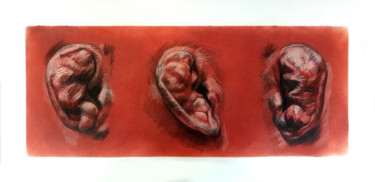


让我们知道您是否想看到这件艺术品的更多照片!
- 工作的背面 / 工作的一面
- 细节 / 签名 / 艺术品的表面或纹理
- 情境中的艺术品, 其他...
If You Can’t Hear the Ovations, You’ve Won (2025) 图画 由 Anton Terziev
更多信息
- 包装 (盒子或纸箱包装) 所有的作品都配有优质的承运方,经过严格的包装保护和已投保。
- 监控 跟踪订单,直到包裹交付给买方. 将提供跟踪号码,以便您可以实时跟踪包裹。
- 延迟 全球配送会在3-7天内送达 (估计)
- 不包括海关 价格不包括海关费用。大多数国家/地区对原创艺术品没有进口税,但您可能需要支付减免的增值税。海关费用(如果有)将由海关在抵达时计算,并由承运人单独计费。
更多信息
- 可追踪的在线真品证书 可以通过扫描插图的代码随时在线验证真品证书。
- 认证评级艺术家 专家研究一个艺术家的工作和职业生涯,然后建立一个独立的,可靠的平均价格值。平均价格价值座落在一个价格范围内的某一时期的艺术家。专家们也可能被要求建立一个更精确的估计为特定的工作。
更多信息
使用SSL证书进行100%安全付款 + 3D Secure.
更多信息
购买许可证以将此图像用于您的网站、通信或销售衍生产品。
Usage: 网络许可证
| 727 px | ||

|
1500 px |
| 文件尺寸 (px) | 727x1500 |
| 全球使用 | 是 |
| 用于多点支持 | 是 |
| 用于任何类型的媒体 | 是 |
| 转售权 | 没有 |
| 最大打印数量 | 0 (Zero) |
| 拟出售的产品 | 没有 |
购买后立即下载
此图片可以用许可证下载: 您可以随时下载它们。
限制
所有在ArtMajeur的图像是由艺术家创作的原创作品,所有权利是严格保留的。获得许可证后有权根据相应条款使用或利用图像。可以进行微小的修改,如重构或重新聚焦图像,使其完全符合新项目要求,但是,禁止进行任何可能损害原始作品的修改。其完整性(形状修改,扭曲,切割,改变颜色,添加元素等),除非事先从艺术家获得书面授权。
定制许可证
如果您的用途不在我们的标准许可证范围内,请联系我们获取定制许可证。
艺术图片银行-
原创艺术品 (One Of A Kind)
图画,
木炭
/
纸
在纸上
- 外形尺寸 高度 13.6in, 宽度 27.6in
- 艺术品状况 艺术品完好无损
- 是否含画框 此作品未装裱
- 分类 画图 低于US$5,000 武术
Terziev’s use of sanguine(red chalk) evokes a venerable artistic tradition, one stretching back to the Renaissance when artists such as Leonardo da Vinci and Michelangelo employed red chalk for warm, lifelike figure studies. Sanguine’s subtlety allows for the gentle modeling of forms and gradations of flesh tones, lending a raw intimacy to the work. Meanwhile, charcoal offers dramatic contrast: the deep black contours reinforce the ridges and folds of the damaged cartilage. This interplay between sanguine and charcoal is reminiscent of 17th- and 18th-century academic drawing methods, yet Terziev channels it into an unmistakably contemporary commentary.
The triptych of ears at the center of the composition speaks to the transformation of the body under extreme physical stress. Cauliflower ear—common among wrestlers, judokas, and MMA fighters—results from blunt trauma that disrupts the cartilage. In Terziev’s rendering, each ear is shown from a slightly different angle, highlighting the variety of shapes and distortions that can occur. These variations suggest both the resilience of the human body and the marks it carries from repeated violence.
By isolating the ear in the pictorial space, Terziev focuses attention on an often-overlooked body part, framing it as a stand-in for the entire fighter’s journey. The textured surfaces, accentuated by the soft red background, are reminiscent of bruised flesh—an echo of the physical punishment endured in the ring or cage. The bold, warm hue behind the ears underscores the presence of blood, passion, and the raw nature of combat.
The title, “If You Can’t Hear the Ovations, You’ve Won” is as evocative as the imagery itself. It hints at the paradoxical reality of combat sports: even as a victor stands in the spotlight, celebrated by cheering crowds, the body may be too battered or altered to fully register that triumph. The title’s wry tone also suggests a certain stoicism—winning at all costs, to the point where the fighter may no longer hear the very applause for which they’ve fought.
In art-historical context, ears have served as potent symbols in works referencing sacrifice, suffering, or transformation. From the infamous story of Vincent van Gogh’s self-mutilation to more metaphorical uses of the ear in Surrealist art, artists have long recognized that the ear can be both vulnerable and deeply expressive. Terziev’s composition taps into that tradition, but locates it firmly in the visceral world of contemporary sports culture.
The choice to depict a body part marred by conflict can evoke discomfort in the viewer. Yet this discomfort is central to the piece’s power. Much like the baroque painters who dwelled on the drama of the body under duress, Terziev lays bare the unvarnished, corporeal truth of athletic struggle. His medium—sanguine—historically admired for capturing the softness of skin—here is used to capture the hardness of trauma. Charcoal’s stark black lines add further tension, making the swollen contours of the ears all the more dramatic.
Visually, the red background intensifies the sensation that the flesh itself is throbbing with pain, or that we are peering into a layer beneath the surface. The near-monochrome palette conjures an atmosphere of internal heat, recalling the fervor of competition and the rush of adrenaline.
“If You Can’t Hear the Ovations, You’ve Won” exemplifies Anton Terziev’s ability to fuse classical drawing techniques with modern, provocative subject matter. In doing so, he elevates a detail—cauliflower ears—commonly dismissed or viewed with mild horror, into a testament to human resilience, the cost of glory, and the sometimes paradoxical nature of victory. By isolating and monumentalizing these wounded ears, Terziev reminds us that every accolade may come at a price. In the lineage of art history, this work stands as both an homage to the discipline of draftsmanship and a reflection on the intimate, bodily consequences of contemporary combat sports.
相关主题
安东·泰尔齐耶夫 (Anton Terziev) 是一位当代保加利亚艺术家,他是一位运用尖锐讽刺作为艺术工具来处理各种当代主题的大师。他的作品的特点是对图像的深刻运用,传达了鲜明而批判性的意象。在他的艺术作品中,安东巧妙地将赌注、技巧和讲故事的元素编织在一起,产生了具象的当代艺术,其中带有社会评论、幽默和关于艺术家状况的信息。
安东·泰尔齐耶夫 (Anton Terziev) 从两个不同的来源汲取灵感。首先,他的艺术往往源于现实生活中的事件,以激发他的创作过程的方式在他周围展开。其次,他的想象力在他的作品中发挥着关键作用,使他能够创作出生动且发人深省的图像。他的每件作品都装饰着从电影和书籍中提取的流行文化的微妙元素。每件作品中都蕴含着一种叙事,一种元文本,既丰富了观众的体验,又不会让他们不知所措,因为安东相信,好的艺术可以温和而有效地进行交流。
安东作品的独特之处在于他坚定不移地致力于给观众留下一种无限的惊奇感。他的作品邀请观众与艺术进行对话,鼓励他们解释、质疑和探索他所呈现的叙事。为他的作品选择完美的标题是一个挑战,他经常从文学、电影或音乐中汲取灵感来应对。
安东·泰尔齐耶夫的画家生涯与他的作家身份错综复杂地交织在一起。他的想法以绘画和艺术品的形式得以体现,体现了他多样化的才能。除了绘画之外,他还通过表演、电影制作和设计将他的艺术愿景变为现实,展示了多方面的创意表达方式。







